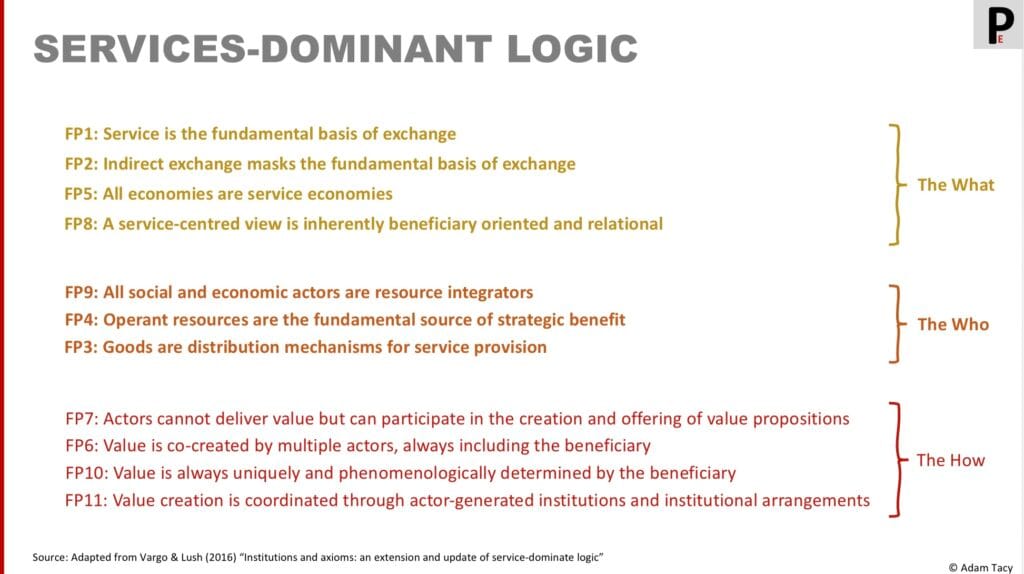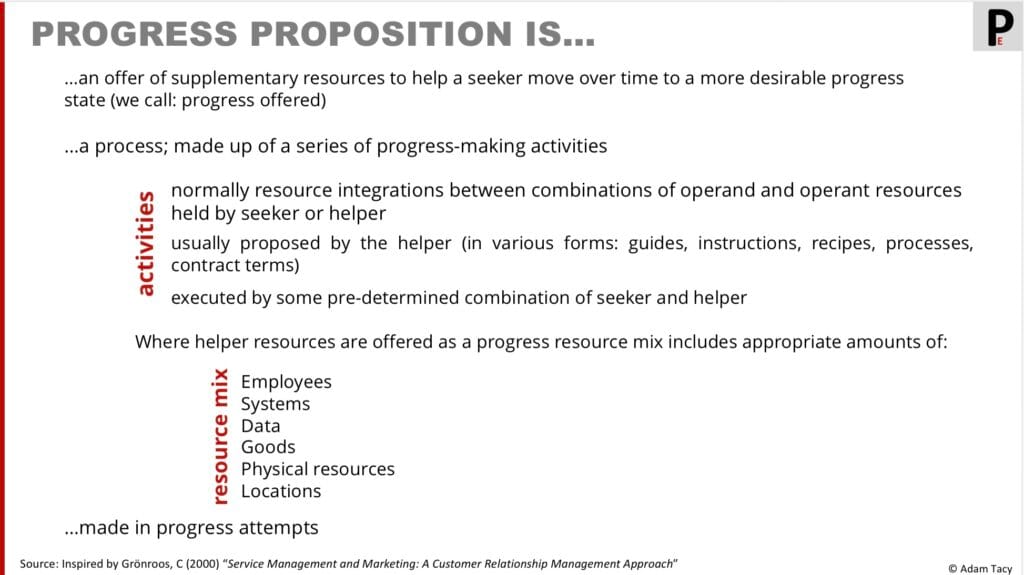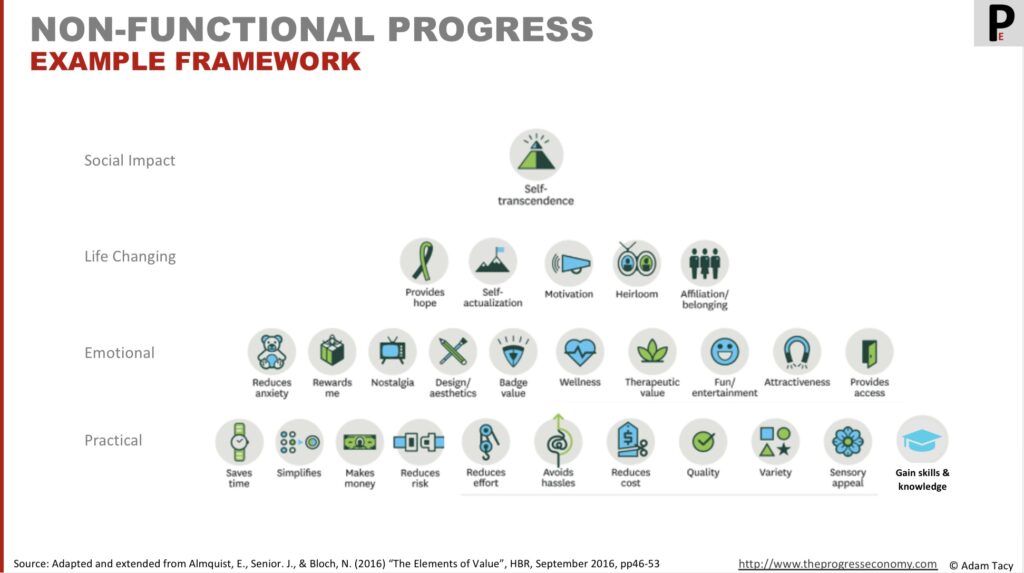The progress economy is an actionable lens. As a result, it offers a very helpful collection of tools that enable our methodical search for innovation, growth and firing up the circular economy.
The four conceptual layers of the lens — foundation, decision, operation, and strategic — are where the tools are located. And, in practice, when hunting innovation, growth and/or circular economy thinking, we would often use a combination of the tools.
A summary of the tools are collected on this page, with links to their full drescriptions. And they are grouped in their respective layers.
So, let’s start with the foundation layer (you can find the other layers quickly, either in the table of contents above, or here: strategic, operational, and decision).
Foundation layer tools

In the foundation layer we find the underlying service-dominant logic on which the progress economy builds. And sitting along side are our main definitions. Together with the explanation of a couple of key concepts.
- Service-dominant Logic
- Definitions of progress, progress propositions, and innovation
- What does value mean in the progress economy?
- How is cash/price seen in the progress economy?
- Definition of markets
We’ll kick of with the foundational service-dominant logic.

Service-dominant Logic
Link to tool: service-dominant logic
Vargo & Lush’s service-dominant logic unlocks our whole thinking. It emerged from the approach of seeing value not as embedded in an output, but rather value is created in process of creating the outcome. And that the view of service in relation to goods is not as terrible as classic marketing would lead you to believe.
The world view should be that service is the fundamental basis of exchange.
Taking a view that fundamentally everything we do is exchanging services, service-dominant logic’s development has arrived at 11 foundational premises. And 5 of those are seen as axioms. As the foundational premises were built up over time, I feel they can benefit from a little re-ordering and grouping.

Service-dominant logic informs our view of value, value creation, and why there’s no need for a goods vs service perspective (goods are distribution mechanisms (in time and space) of service). Additionally it leads our thoughts on the role of cash – as a successful implementation of service credits – given that the logic removes the point of exchange of value.
Understanding service-dominant logic helps understanding key aspects of the progress economy.
You can read more on service-dominant logic and the individual premises over here.

Definition of progress
Link to tool: progress
Making progress is at the root of the progress economy. We define it, at the simple level as
progress – moving over time to a more desirable state
But behind this simplistic definition is some powerful thinking.
Progress comprises functional and non-functional elements, informed by progress.

It is also seen as:
- progress sought
- progress achieved – how much progress towards progress sought been made at a particular point in time
- progress potential – how much more progress can be made from a particular point in time
Understanding progress is crucial to exploring the progress economy.
You can explore the definition of progress over here.

Definition of progress proposition
Link to tool: progress propositions
Progress propositions arise as a means to address progress seekers lack of resources hurdle when they want to make some specific progress. Progress helpers form offering these propositions: progress offered.
Our defnition of progress proposition is simply:
progress proposition – an offer to help make progress
In the old days we might have called this service. But that only invites an inaccurate comparison of service vs goods. Service-dominant logic informs us that goods are distribution mechanisms of service. And therefore we see goods as a potential element of a service mix offered as part of the proposition.

We can say that a progress proposition consists of a service mix and a set of defined activities.
The relationship between progress sought and progress offered is shown in the strategic progress diamond tool. It is also a ripe zone for innovation.
Understanding progress propositions (and the engagement decision process) opens up the world of systematic innovation (driving growth and enabling the progress economy).
You can explore the definition of progress proposition over here.

Definition of Innovation
Link to tool: innovation
Many definitions of innovation are vague (often deliberately so). For the progress economy we can be much more actionable. Simplistically it is about creating and executing a new progress proposition that is better for progress seekers without damaging the progress helper.
More formally,
innovation – creating and executing a new – to the firm, industry/market or world – progress proposition that
i) offers to help make better progress, or
ii) offers to help make progress better, or
iii) reduces one or more of the 6 hurdles to engagement, or
iv) is some combination of the above
which also ensures, or improves, the survivability of the progress helper (entity or ecosystem)
There are several ways of systematically hunting innovation. Altering the service mix, updating proposed activities, flexing progress offered (where we also find the basis for disruptive innovation and blue ocean strategy), reducing those hurdles…
You can explore the definition of innovation over here.

What does value mean
Link to tool: value
A product’s value to customers is, simply, the greatest amount of money they would pay for it
“Market strategy and the price-value model” Golub, H. and Henry, J.
[The fundamental aspect of the progress economy is that we see Value differently. It is not seen as embedded by successive manufacturers in a supply change. Nor is it exchanged in a value-in-exchange moment. For example at a point of sale. To then be used up/destroyed by a customer. Who may also try and recover some value by repair, re-use, recycle, re-sale. But all that is usually done past the point of interest, and often visibility, of manufacturers.
Rather, value is a subjective determination of amount of progress achieved. Due to the joint nature of making progress with a progress proposition, it can be viewed/termed value co-creation and value-in-use. It is also a subjective determination of remaining progress potential.
Overwhelmingly it is determined by the progress seeker.
Though the progress helper may determine progress is being held up by the seeker. And in relatively rare occassions the helper may terminate engagement.
We also need to guard against value co-destruction.]

Role of cash/price
Link to tool: price
[Snce there is no value-in-exchange in the progress economy then we have to re-imagine the role of cash and price.]

Definition of markets
Link to tool: markets
The progress economy encourages us to define markets by progress sought. This is not new, and reaches back to Levitt’s 1975 paper on paper ”Marketing Myopia”. But Christensen has a key observation:
The great Harvard marketing professor Theodore Levitt used to tell his students, “People don’t want to buy a quarter-inch drill. They want a quarter-inch hole!” Every marketer we know agrees with Levitt’s insight. Yet these same people segment their markets by type of drill and by price point…
Marketing malpractice” Christensen, C. M., Cook, S., Hall, T. Harvard Business Review (2005)
Since we focus only on progress, we see only the ”quarter-inch hole” aspect. We define markets as
market – a group of progress seekers who want to make sufficiently similar progress.
Understanding markets allows us to interpret progress, find new markets (progress sought) and minimise myopia in innovation.
You can explore more about markets over here.
Strategic layer tools

Sitting at the top level of the progress economy is the strategic layer. This is where we find the progress diamond tool. This tool is where we visualise how progress sought and progress offered meet – a zone of innovation.
We additionally find 3 helper tools that come from elsewhere, though are useful in understanding and exploiting the progress economy. Firstly a hierarchy of non-functional progress examples. Next is Christensen’s disruptive innovation. And, thirdly, Kim & Mauborgne’s Blue Ocean Strategy.

Progress diamond
Link to tool:
The progress diamond tool is where we visualise progress sought meeting progress offered. It shows the innovation zone at this strategic level.
Using the tool we can reason about what offering to help make better progress and/or progress better means.
It also allows us to understand markets.
And informs us of the whys behind Christensen’s disruptive innovation theory (from The Innovator’s Dilemma) as well as Kim & Mauborgne Blue Ocean Strategy.

Hierarchy of non-functional progress
Link to tool:
It’s helpful to have some guidance on what non-functional progress could mean. And Almquist, Senior and Bloch provide a nice hierarchy in their article ”The Elements of Value”.
If we remove a couple of elements that are more functional progress and rename the lowest layer it becomes a useful prompt tool when considering non-functional progress.


Disruptive innovation (Christensen)
Link to tool:

Blue ocean strategy (Kim & Mauborgne)
Link to tool:
Operation layer tools


Progress zip
Link to tool:

Proposition as characteristics
Link to tool:

Service mix
Link to tool:

Service-Service continuum
Link to tool:

models
Link to tool:

Orientations
Link to tool:

Ecosystem
Link to tool:
- Progress zip – high level view of how progress is made (value in use, co-creation of value, temporary coming together of resources)
- Service as characteristics model – a more detailed view of how progress is made based on Gallouj & Weinstein model [temporarily see here, and here; and my update here as well as how this can be used to describe/find innovation areas]
- Service mix – the particular combination of progress offerer’s staff, physical resources, systems and goods offered to help seekers make progress [temporarily see here]. Altering the service mix is a source of innovation
- Service-service continuum – helps us understand/reason about the impact on progress seeker as we alter a service mix. Moving between enabling and relieving service. Or guiding us on tour of service once we understand the seeker’s desires better [temporarily see here]
- Service execution – what internal skills does an enterprise/ecosystem need to implement/execute an innovation? (Uses updated den Hertog models) [temporarily see here]
- understanding and manipulating innovation execution complexity [temporarily see here]
- Orientations – what mindsets do we need to implement innovations [temporarily see here]
- Ecosystem – fundamental to service execution, often held together/co-ordinated by a progress offerer, but a progress seeker can also be involved (and that may be a source of innovation/advantage – eg choosing a delivery approach for online purchases)
- Value co-destruction – we need to guard against value co-destruction [temporarily see here]
- (Progress proposition owners)
(Enterprise set up)
Decision layer tools


Engagement decision process

Lack of resources

Adoptability

Resistance

Mismatch on service-service continuum

Confidence in progress helper


Let’s progress together through discussion…